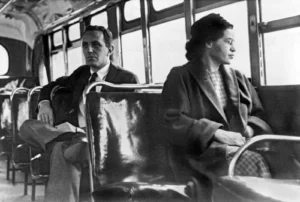Lessons from the Bus Boycott for a Nation on The Edge of a General Strike
By Dancing Quail
In December 1955, Rosa Parks made a choice that would echo throughout history. On a bus in Montgomery, Alabama, she refused to give up her seat to a white man, challenging Jim Crow laws that controlled where Black passengers could sit. Parks was not acting alone. She was the secretary of the Montgomery chapter of the NAACP, an organization that had been laying the groundwork for challenging segregation through legal cases, community organizing, and public advocacy. Her long-standing involvement with the NAACP connected her to a network of activists ready to transform her arrest into a catalyst for change.
While she became the face of the Montgomery Bus Boycott, Parks was not the first to resist such injustice. Women like Claudette Colvin, Aurelia Browder, and Mary Louise Smith had also defied segregation rules before her. Still, Parks’ arrest, along with the leadership of Dr. Martin Luther King Jr. and the Montgomery Improvement Association, became the spark that ignited a year-long bus boycott and a legal battle that would go all the way to the U.S. Supreme Court.
The Montgomery Bus Boycott was more than a protest against unfair transportation laws; it was a demonstration of the power of coordinated, sustained action. For 381 days, Black residents refused to ride the buses, walking miles to work and organizing carpools. Their persistence led to Browder v. Gayle, the case that ultimately struck down bus segregation as unconstitutional in 1956.
Then and Now: Echoes Across Time
The political climate of the mid-1950s was characterized by entrenched authority and systemic inequality. Southern states clung fiercely to segregation, supported by laws, police actions, and cultural norms. Public opposition was met with threats, arrests, and violence. However, grassroots movements, rooted in local communities and fueled by shared struggles, laid the foundation for national change.
While the legal systems that upheld racial segregation have been dismantled, a different form of segregation has emerged. In the 1950s, laws and customs deliberately separated communities by race, limiting access to education, housing, and economic opportunities. Today, the lines of division are often based on wealth rather than skin color. Entire neighborhoods are segregated by income, with underfunded schools, limited healthcare, and few job opportunities concentrated in working-class and low-income areas.
As racial segregation was enforced through policies and power, economic segregation is sustained by housing markets, wage suppression, corporate influence over politics, and a tax system that favors the wealthy. Both systems foster deep-rooted inequality, and both require collective action to dismantle.
Just as in Montgomery, a growing undercurrent of unrest is evident. Workers are striking across various industries, from logistics to healthcare. Communities are challenging the legitimacy of laws and systems that seem to prioritize profits over people. And like the citizens of Montgomery, we face a choice: accept the gradual loss of our rights or come together in coordinated action.
Rosa Was the Catalyst! You Can Be Too

It’s important to remember that Rosa Parks did not act alone, and the boycott did not happen overnight. It was built on years of quiet preparation, networks of trust, and a readiness to seize the moment when the spark came. Parks was the catalyst, but the movement’s strength came from thousands of ordinary people refusing to comply with an unjust system.
The Call to Prepare
History shows us that change doesn’t come from isolated protests. It arises from organized, collective action that targets powerful institutions where they are most vulnerable: their profits. Recent years have shown that boycotts can still produce significant results. Public backlash against companies like Tesla over the CEO’s controversial actions, Target over political controversies, and Bud Light after a marketing backlash led to measurable financial losses and public relations crises. Although different motivations drove these examples, they reveal a larger truth: when enough people refuse to buy a product or engage with a system, even the most powerful corporations must respond. A coordinated general strike uses the same principle on a larger scale, aiming at not just one company but the entire economic system that sustains inequality.
That’s why The Survival Guide for a General Strike exists: to provide you with the knowledge, strategies, and resources to get ready. Just as the people of Montgomery had carpools and community kitchens, we need networks of mutual aid, communication, and solidarity in place before the crisis happens.
The lessons from Montgomery are clear: injustice can be overcome, but only if we’re willing to stand together, plan, and stay committed over the long term. The next catalyst is on its way. Will you be prepared?
Get your copy of The Survival Guide for a General Strike today and join the movement to reclaim our future.
